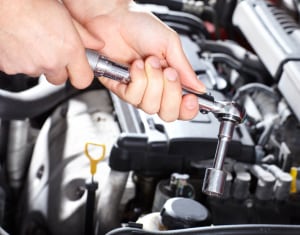

Everyone with a driver's license and a car knows auto repair costs can be extremely high: the average repair bill in the U.S. comes to $305.56. But the reality is that not keeping up with auto repairs and maintenance can turn out to be even more costly. The longer you put off a repair, the more the problem is likely to grow. Plus, the bill for accidents caused by unperformed maintenance tops a whopping $2 billion every single year. It is important you remember that doing basic maintenance and repairs is simply part of the cost of owning a car.
That doesn’t mean, however, that you can not do anything to keep auto repair costs down. There are some auto repair services that it’s simply not worth doing on your own; given that synthetic oil now only needs to be changed every 7,000 to 10,000 miles, for example, you probably won’t save enough to make changing your own oil worth it (especially since you’ll need to buy specialized equipment and probably pay disposal fees for the contaminated oil). But there are certain skills all drivers should have, both for financial and safety reasons. Here are five of the most important:
You need to keep a tire pressure gauge in your car, know how to read it, and actually add air to your tires if they’re low. You might not be used to doing this task because it’s generally included in your annual inspection at the auto shop, but tire pressure actually tends to significantly change at least twice a year. Underinflated tires can lead to accidents, so it’s important you do regular checks in between professional service.
Knowing when to get new tires is essential for safety. Your treads should never be shallower than 2/32 of an inch, but 4/32 of an inch is a safer margin.
The tanks for all the basic fluids that keep your car running as it should are designed to be accessible, so it doesn’t take much to pop the hood and get familiar with them. Keep an eye not only on levels but also on quality; if your brake fluid looks like motor oil, for example, that’s a sign you need to take the car in to have the brake lines flushed. Brake repairs may not be cheap, but they’re a lot cheaper than totaling your car because your brakes stop working.
It’s important to fix burned-out head, tail and brake lights as soon as possible so your car is always visible. While the process is slightly different for lights in the front and back of your car (going through the engine compartment vs. removing the lens), either will probably take only a few minutes once you consult your owner’s manual for instructions.
You can probably have your auto repair shop take care of this whenever you’re due for an oil change, but it’s a good idea to know-how in case your wipers wear out to the point of limiting visibility and you need to change the blades ASAP. Just slide the old blade off and click the new one into place -- it gets easier with practice.
What basic maintenance do you prefer to perform yourself in order to keep auto repair costs down, and what would you rather leave to the pros? Join the discussion in the comments. Lastly, we hope this article about auto skills and owning a driver's license has helped you.